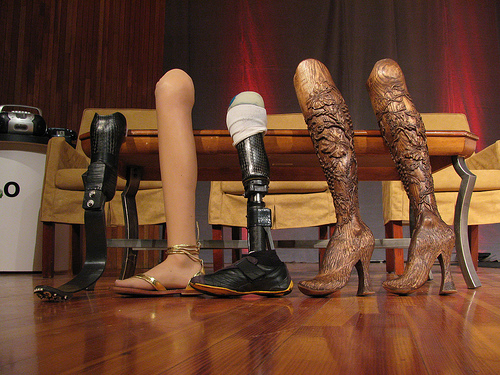Games can be used to change our behavior — make something fun, and we are likely to do it again and again. Psychologists call is positive reinforcement. Pleasure triggers our amygdalas — makes us make strong neural connections between the activity and positive emotion. Thrills are memorable and we seeks them out in our daily lives. Here are two examples of using fun to change people’s behavior, to make us do something we ordinarily don’t particularly want to: climb stairs and recycle. November 17th Update A fellow member of the Human Factors and Ergonomics Society (HFES), David Watts, recommended the following:
Pipsqueak Articles
Posts written by Olga Werby or Christopher Werby
Conceptual Design, Pipsqueak Articles, Product Design Strategy, Scaffolding, Users
Special Preview: Social Media by Thomas Erickson
by Olga Werby •
Interfaces.com was given a free advanced preview of Thomas Erickson’s report and videos on social computing. The videos are very well produced and provide an interesting point of view and good insights on social media. Below are few of my notes based on the video content and ideas discussed on this blog in the past (my former students should find these familiar). Social Media Definitions & Ideas Social Computing: this is really about groups working together using ICT (Information Communication Technologies). I think this is a broader definition then the one offered by Thomas Erickson, as it includes all forms of ICT. Social Scaffolding: we all have a set of social scripts — culturally-specific, socially constructed norms of behavior — that help us navigate group interactions and allow for self-organization of crowds, at least shot-term and for a limited goal (like crossing the street). [Please watch Dr. Erickson’s example of street crossing in “Video 4.3: Social Computing video 3 – Face-to-face Interaction as Inspiration for Designing Social Computing Systems”.] Product design needs to create opportunities for social interaction — these scaffolds have to be built into the system: meeting spaces, places to sit down, well-lit areas, easy communication tools, games,…
Attention Controls Errors, Interface Design, Perceptual Blindness, Pipsqueak Articles
Failure to Communicate
by Olga Werby •
Conceptual Design, Cultural Bias, Interaction Design, Interface Design, Mental Model Traps, Pipsqueak Articles, Product Design Strategy
Design for Emotion, for Empowerment
by Olga Werby •

I use a cane to get around, a consequence of an unfortunate encounter with a taxi many years ago. I have many different canes (each heel size, for example, requires its own cane). All are cool. Some have animal carvings, some have silver, some have gold, some are complex in design, some are very Deco in style, and one has a sword (another a compass and a secret compartment). I get stopped on the street all the time — people love my canes and always comment. I was even told once that my limp is sexy — whatever… What I don’t have is an “old woman” cane — the kind you buy at a pharmacy. I’m just not that old, and plan never to be that old. I want funky, I want things that match my outfits and my moods. And I want them functional: the right hight, the right feel of the cane handle, the stability of the tip, the light weight, the structural security. I want it all and I want it sexy. Cane is a product — a very personal one. But most are stuck with poorly designed, boring, ugly, you-make-me-feel-like-an-invalid cane. Why? Aimee Mullins is a…
Background Knowledge, Conceptual Design, Pipsqueak Articles, Product Design Strategy
Explaining SEO to Clients
by Olga Werby •
I’ve been in meetings where SEO was thrown around like some magic power word — feel like you need to make your arguments stronger? Just say the word! So it’s good that Google made a nice, unthreatening video (note the pink tee-shirt) explaining its position on SEO — “It’s not spam!” — (good to know), that can be shown to clients. Google’s authority on this matter helps alleviate some of the clients’ fears and makes developers’ job a bit easier… Enjoy:
Cognitive Blindness, Mental Model Traps, Pipsqueak Articles
Intel i5 Core Commercial: When a company just doesn’t get it
by Olga Werby •
Sometimes, a company just doesn’t get it: it’s not about what a product can theoretically do, but what it can do for the user. Intel has a history of making a particular type of commercials — “the power inside” commercials, I call them. Intel marketing people use the following mental model: people/men like muscle cars; people like powerful things; thus if we emphasize the power “on the inside” people would like our computers. And so their current commercials for Intel i5 Core look like this: So what’s wrong with this? It’s all about them, it’s not about me. I don’t care what’s inside the machine, I care what it can do for me. Or, more accurately, what I can do with it. It’s about my performance. Imagine going to a car lot and the car salesmen tells you: “It got huge pistons. I mean HUGE. You’ve got to see those pistons!” Perhaps some car buyers would get inspired by such language, but I bet most would find it puzzling. Why should I care? Does it drive well? What’s the performance like? Maneuverability? Intel’s commercials about its chips are just like a car manufacturer’s fetish remarks about pistons. Sure some would…
Background Knowledge Errors, Cognitive Blindness, Errors, Mental Model Traps, Mirroring Errors, Pipsqueak Articles, Product Design Strategy
Socially Constructed Beliefs
by Olga Werby •

American Academy of Pediatrics (AAP) came out with a strong recommendation against the use of bumpers in cribs. The September 2007 issue of The Journal of Pediatrics examined deaths and injuries attributed to infant crib bumper pads: “Twenty-seven accidental deaths reported by medical examiners or coroners were attributed to bumper pads. The mechanism of death included suffocation and strangulation by bumper ties. Twenty-five nonfatal injuries were identified, and most consisted of minor contusions. All retail bumpers had hazardous properties.” AAP has finally announced that it is formally against bumpers. That certainly took a while. And, amazingly, the bumper pads are still for sale by all major baby room outfitters, and parents are still buying them and using them with their beloved offspring. Why? Why would parents knowingly endanger their children? This is an interesting case of Mental Model Traps, Mirroring Errors, and Cognitive Blindness. Mental Model Traps Let’s start by Mental Model Traps that parents fall into in this particular case. To do this, we need to back up in time a bit. The design of children’s beds had undergone considerable evolution over the last few centuries. Cribs used to be just large baskets with tightly woven sides. The weave…

